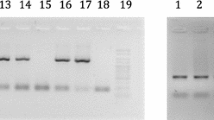Abstract
In a case-control study that included a total of 98 patients and 83 controls, the possible link between various pathogens and abdominal aortic aneurysms was investigated. For 68 patients with abdominal aortic aneurysm and age-matched controls, no differences were detected in the levels of immunoglobulin (Ig)A and IgG Chlamydiaceae and Chlamydophila pneumoniae antibodies. Patients with IgA titers positive for Chlamydophila pneumoniae showed progressive disease (defined as an annual increase of the aneurysm diameter of ≥0.5 cm) more frequently than patients with negative IgA titers (p = 0.046). Polymerase chain reactions performed to detect DNA for Chlamydophila pneumoniae, Chlamydia trachomatis, Chlamydophila psittaci, human cytomegalovirus, Borrelia burgdorferi and Helicobacter pylori in tissue specimens of 30 patients and 15 controls were negative. In summary, Chlamydophila pneumoniae may contribute to aortic aneurysm disease progression, but DNA of this and other pathogens was not found in patients’ specimens.

Similar content being viewed by others
References
Ernst CB (1993) Abdominal aortic aneurysm. N Engl J Med 328:1167–1172
Lindholt JS, Shi GP (2006) Chronic inflammation, immune response, and infection in abdominal aortic aneurysms. Eur J Vasc Endovasc Surg 31:453–463
Lindholt JS, Fasting H, Henneberg EW, Ostergaard L (1999) A review of Chlamydia pneumoniae and atherosclerosis. Eur J Vasc Endovasc Surg 17:283–289
Ngeh J, Anand V, Gupta S (2002) Chlamydia pneumoniae and atherosclerosis—what we know and what we don’t. Clin Microbiol Infect 8:2–13
Bishara J, Pitlik S, Kazakov A, Sahar G, Haddad M, Vojdani A, Rosenberg S, Samra Z (2003) Failure to detect Chlamydia pneumoniae by cell culture and polymerase chain reaction in major arteries of 93 patients with atherosclerosis. Eur J Clin Microbiol Infect Dis 22:300–302
Daus H, Ozbek C, Saage D, Scheller B, Schieffer H, Pfreundschuh M, Gause A (1998) Lack of evidence for a pathogenic role of Chlamydia pneumoniae and cytomegalovirus infection in coronary atheroma formation. Cardiology 90:83–88
Gaydos CA, Summersgill JT, Sahney NN, Ramirez JA, Quinn TC (1996) Replication of Chlamydia pneumoniae in vitro in human macrophages, endothelial cells, and aortic artery smooth muscle cells. Infect Immun 64:1614–1620
Kalayoglu MV, Byrne GI (1998) A Chlamydia pneumoniae component that induces macrophage foam cell formation is chlamydial lipopolysaccharide. Infect Immun 66:5067–5072
Ullmannova V, Haskovec C (2003) The use of housekeeping genes (HKG) as an internal control for the detection of gene expression by quantitative real-time RT-PCR. Folia Biol (Praha) 49:211–216
Walder G, Hotzel H, Brezinka C, Gritsch W, Tauber R, Würzner R, Ploner F (2005) An unusual case of sepsis during pregnancy: recognizing infection with Chlamydophila abortus. Obstet Gynecol 106:1215–1217
Lindholt JS, Juul S, Vammen S, Lind I, Fasting H, Henneberg EW (1999) Immunoglobulin A antibodies against Chlamydia pneumoniae are associated with expansion of abdominal aortic aneurysm. Br J Surg 86:634–638
Lindholt JS, Ashton HA, Scott RA (2001) Indicators of infection with Chlamydia pneumoniae are associated with expansion of abdominal aortic aneurysms. J Vasc Surg 34:212–215
Ma-Krupa W, Kwan M, Goronzy JJ, Weyand CM (2005) Toll-like receptors in giant cell arteritis. Clin Immunol 115:38–46
Lindholt JS, Stovring J, Ostergaard L, Urbonavicius S, Henneberg EW, Honore B, Vorum H (2004) Serum antibodies against Chlamydia pneumoniae outer membrane protein cross-react with the heavy chain of immunoglobulin in the wall of abdominal aortic aneurysms. Circulation 109:2097–2102
Maraha B, den Heijer M, Kluytmans J, Peeters M (2004) Impact of serological methodology on assessment of the link between Chlamydia pneumoniae and vascular diseases. Clin Diagn Lab Immunol 11:789–791
Acknowledgments
The study was supported by the European Union (QLK-CT-2002-00882 and LSHB-CT-2005-512061), the Research Fund of the Austrian National Bank (no. 8825, no. 9715), the Tyrolean Research Fund (project no. 0404/121), the Ludwig Boltzmann Society, the Federal State of Tyrol, and the “Verein zur Förderung der Hämatologie, Onkologie und Immunologie,” Innsbruck, Austria. We wish to thank the technical assistants from the virological–serological laboratory for their helpful support.
Author information
Authors and Affiliations
Consortia
Corresponding author
Rights and permissions
About this article
Cite this article
Falkensammer, B., Duftner, C., Seiler, R. et al. Lack of microbial DNA in tissue specimens of patients with abdominal aortic aneurysms and positive Chlamydiales serology. Eur J Clin Microbiol Infect Dis 26, 141–145 (2007). https://doi.org/10.1007/s10096-006-0245-5
Published:
Issue Date:
DOI: https://doi.org/10.1007/s10096-006-0245-5




